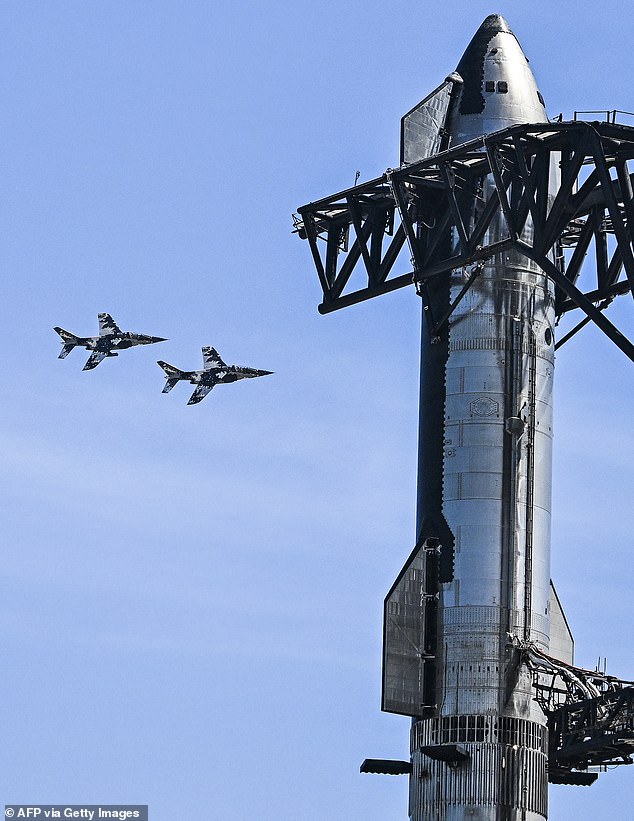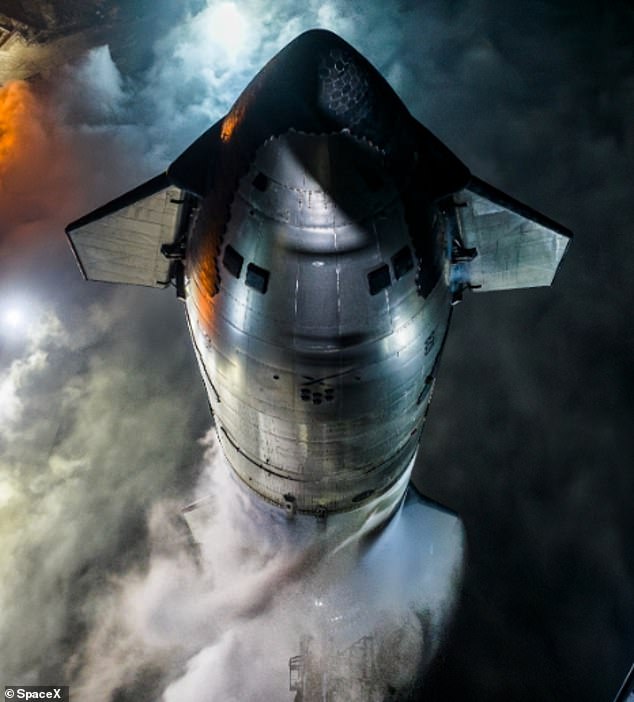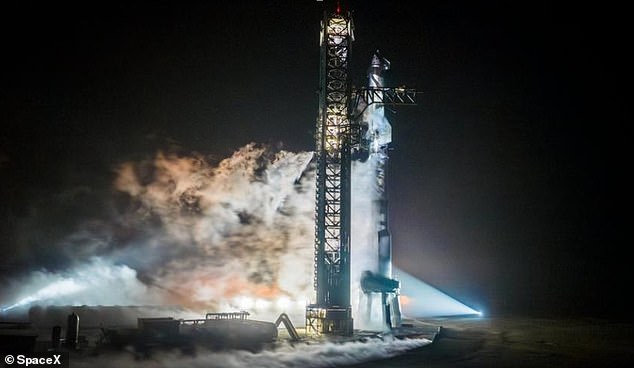After two explosive failed attempts, Elon Musk’s SpaceX will attempt to launch its £2.4bn Starship rocket into orbit for the third time today.
Starship, the most powerful rocket ever built, will launch from the company’s ‘Starbase’ site in Boca Chica, Texas, no earlier than 7am local time (noon in the UK).
Although it’s unclear what the target altitude is, today’s flight will aim to reach the kind of speeds that put a vehicle into orbit: around 17,500 miles per hour.
About an hour after liftoff, Starship will return to Earth and land in the Indian Ocean, where its parts will be recovered for reuse.
Before the launch, Musk tweeted: ‘Starship launch attempt in ~5 hours. Let’s go to Mars.

SpaceX’s £2.4bn ($3bn) Starship, the vehicle that will one day take humans to Mars, will attempt orbital flight for the third time today. In the photo, the rocket on March 13 ready to operate at its Starbase facility in Texas.
About 30 minutes before takeoff, a live webcast of the flight test will begin, which you can watch on SpaceX website and account x.
MailOnline will also be covering the launch live, so be sure to check back at 12:00 GMT!
If all goes according to plan, Musk hopes to fully launch Starship at least nine times this year, with the ultimate goal of taking humans to other planets.
SpaceX’s historic launch will act as a milestone in Musk’s ambition to transport people and cargo to the Moon and eventually Mars, making us a “multiplanetary” species.
According to SpaceX, the 110-minute test window for this third Starship launch opens at 7:00 CT (12:00 GMT) on Thursday.
“As with all development testing, the schedule is dynamic and is likely to change,” it says on its website.
Only on Wednesday did the Federal Aviation Administration grant SpaceX a launch license, without which it could not proceed.
“The FAA determined that SpaceX met all safety, environmental, policy and financial responsibility requirements,” he said in a post on X.
Musk’s company has had trouble getting FAA approval after its two failed launches, the first of which ended in an explosion over the Gulf of Mexico in April 2023.
It was supposed to travel 90 miles above the ground for 90 minutes, but shortly after the Super Heavy booster detached, Starship exploded over the Gulf of Mexico off the coast of Texas, about four minutes into the mission.
Then in November, SpaceX made its second launch attempt, but it failed about eight minutes into the test mission when it reached an altitude of 91 miles above the Earth’s surface before exploding.
SpaceX considered both missions a success, referring to the first explosion in April as an “unscheduled rapid takedown.”
After the failed launch of the second Starship, the FAA said it would not authorize SpaceX’s Starship to take off without further safety considerations.


SpaceX has prepared Starship (the passenger transport section) and the Super Heavy booster rocket by filling it with more than 10 million pounds of propellant including liquid methane and liquid oxygen.
But even before the FFA clearance came, SpaceX prepared Starship (the passenger transport section) and the Super Heavy booster rocket by filling it with more than 10 million pounds of propellant, including liquid methane and liquid oxygen.
The massive rocket stands 395 feet tall and has 33 Raptor engines that deliver 17 million pounds of thrust, the force exerted by the rocket that causes it to take off.
The force released by Starship at launch is almost double that of the Saturn V developed by NASA under the Apollo program in the 1960s.
Once a successful orbital flight is achieved, SpaceX will focus on launching valuable satellites and other payloads to orbit on Starship.
But ultimately it has been designed to transport humans, up to 100 of them, to Mars “or other distant destinations.”
SpaceX doesn’t just plan to have a spaceship; Musk has also previously said that his company has built a “factory to make many of these vehicles.”
Ultimately, Musk wants to make human life “multiplanetary,” meaning living on multiple planets, which could require about 1,000 spacecraft.


Earlier this month, SpaceX shared stunning images of the Starship launch test that loaded more than 10 million pounds of propellant onto the ship.


The spacecraft is key to Musk’s plans to make humans a “multiplanetary species,” one that lives on planets other than Earth.
Musk believes that a natural or man-made disaster will eventually cause the end of civilization, requiring relocation to another planet; Mars “being the only realistic option.”
However, the Martian surface is not Starship’s only destination, as it will be used much closer to home.
NASA contracted SpaceX to use Starship to fly astronauts to the Moon as part of the Artemis program (the successor to the Apollo program).
A special lunar variant of the vehicle known as Starship HLS (Starship Human Landing System) will transport astronauts from the Orion spacecraft in lunar orbit to the surface of the moon and back, as part of the Artemis 3 mission in 2026.
Musk has previously estimated that the total development cost of the Starship project will be between $2bn (£1.6bn) and $10bn (£8bn).
He later said it would probably be “closer to two or three (billion) than 10.”
However, SpaceX CFO Bret Johnsen revealed last year that SpaceX has invested more than $3 billion in the Starbase facility and Starship systems from July 2014 to May 2023.
